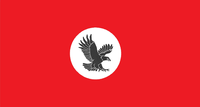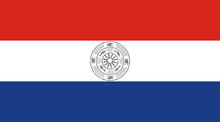Karenni Army
The Karenni Army (Burmese: ကရင်နီ တပ်မတော်; abbreviated KA, KnA or KiA) is the armed wing of the Karenni National Progressive Party (KNPP), and operates in eastern Kayah State (also known as Karenni State), Myanmar (Burma).[5][6]
| Karenni Army | |
|---|---|
ကရင်နီ တပ်မတော် Participant in the Internal conflict in Myanmar | |
 Flag of the Karenni Army | |
| Active | 1957[1] – present |
| Ideology | Karenni nationalism |
| Leaders | Abel Tweed[1] Khu Oo Reh Aung San Myint Shwe Myo Thant |
| Headquarters | Nya Moe, Shadaw Township, Kayah State[2] |
| Area of operations | Kayah State |
| Size | 500[3]–1,500[4] |
| Part of | Karenni National Progressive Party |
| Opponent(s) | State opponents
Non-state opponents |
| Battles and war(s) | Internal conflict in Myanmar |
On 7 March 2012, the government of Myanmar signed a ceasefire agreement with the KNPP, in the presence of international observers from the UN High Commission for Refugees, British Council and the American embassy.[7] A similar ceasefire deal was signed in 1995, but it was dissolved within three months.[7]
History
The British government recognised and guaranteed the independence of the Karenni States in a treaty with the Burmese King Mindon Min in 1875, by which both parties recognised the area as belonging to neither to the Konbaung Dynasty (Kingdom of Burma) nor to the British Empire. Consequently, the Karenni States were never fully incorporated into British Burma. The Karenni States were recognised as tributary to British Burma in 1892, when their rulers agreed to accept a stipend from the British government.[8]
The Constitution of the Union of Burma in 1947 proclaimed that the three Karenni States be united into a single constituent state of the union, called Karenni State. It also gave the possibility of secession from the union after 10 years if the state's leaders were not satisfied with the central government. In August 1948, the Karenni leader U Bee Htu Re was assassinated by a pro-central government militia for his opposition to the inclusion of the Karenni States in the Union of Burma.[8]
Since 1957,[1] the Karenni Army has been fighting government forces in an attempt to create an independent Karenni state, apart from a brief ceasefire in 1995.[6] The KNPP have also fought left-wing groups such as the Kayan New Land Party (KNLP), and the Karenni National People's Liberation Front (KNPLF), both of which are now allied with the Tatmadaw (Myanmar Armed Forces). The group has been accused of using child soldiers, a claim that they have not denied, saying that the children had volunteered willingly, because their parents had been killed during fighting between the KA and government soldiers.[5]
Flags
 Flag of the Karenni Army |
 Flag of the Karenni people, used alongside the flag of the Karenni Army. |
 Flag of the Karenni National Progressive Party (KNPP), used alongside the flag of the Karenni Army. |
References
- "KNPP". www.mmpeacemonitor.org. Retrieved 27 January 2017.
- Murray, Lucy. "Karenni rebels dig in for last stand". Asia Times.
- Burma: Prospects for a Democratic Future, by Robert I. Rotberg
- Burma center for Ethnic Studies, Jan. 2012, "Briefing Paper No. 1" http://www.burmalibrary.org/docs13/BCES-BP-01-ceasefires(en).pdf
- "Child Soldiers in Non-State Armed Groups".
- Karenni Army (KA) (Myanmar), GROUPS - ASIA - ACTIVE
- "Burma: Government, Rebels Sign Ceasefire". UCA News. 8 March 2012. Retrieved 15 March 2012.
- Karenni Independence Through Education